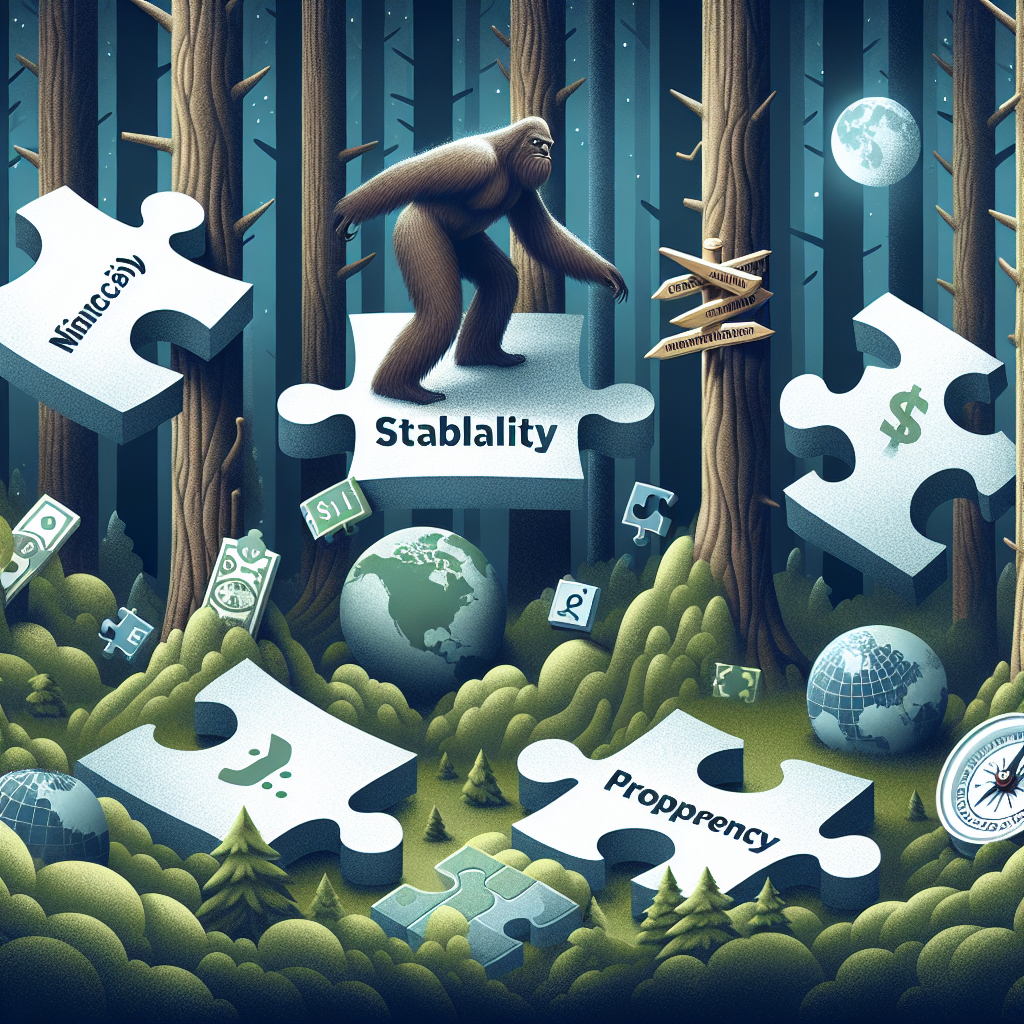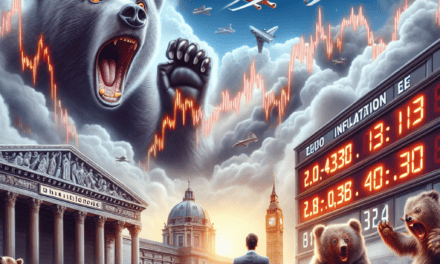“Unraveling the Mystery: Taming the Financial Sasquatch”
Introduction
The Federal Reserve, often referred to as “The Fed,” stands as a cornerstone of the United States’ financial system, wielding significant influence over the nation’s economic stability and growth. Yet, amidst its complex web of responsibilities, the Fed faces a formidable and elusive challenge, akin to the mythical Sasquatch of finance. This challenge is the delicate balancing act of managing inflation, employment, and interest rates in an ever-evolving global economy. As the Fed navigates through unprecedented economic landscapes, marked by rapid technological advancements, geopolitical tensions, and unpredictable market dynamics, its ability to adapt and respond effectively is put to the test. The pursuit of maintaining economic equilibrium while fostering sustainable growth has become a daunting task, requiring innovative strategies and a keen understanding of both domestic and international financial currents. In this intricate dance of monetary policy, the Fed’s greatest challenge remains the pursuit of stability in an inherently unstable world, a quest as elusive and complex as the legendary Sasquatch itself.
Understanding The Fed’s Role In Modern Finance
The Federal Reserve, often referred to simply as “the Fed,” plays a pivotal role in the United States’ financial system, acting as the central bank responsible for implementing monetary policy, regulating banks, maintaining financial stability, and providing financial services. However, one of the most significant challenges it faces is akin to the pursuit of an elusive creature, often dubbed the ‘Sasquatch’ of finance: achieving the delicate balance between fostering economic growth and controlling inflation. This challenge is not only complex but also fraught with uncertainties that make it a formidable task for policymakers.
To understand the Fed’s role in modern finance, it is essential to first grasp its dual mandate: to promote maximum employment and to ensure price stability. These objectives, while seemingly straightforward, often present conflicting demands. For instance, measures that stimulate economic growth, such as lowering interest rates, can lead to inflationary pressures if not carefully managed. Conversely, actions taken to curb inflation, like raising interest rates, can stifle economic growth and increase unemployment. Thus, the Fed must constantly navigate these competing priorities, akin to walking a tightrope where any misstep could have significant repercussions.
Moreover, the globalized nature of today’s economy adds another layer of complexity to the Fed’s task. Economic events in one part of the world can have ripple effects that impact the U.S. economy, necessitating a keen awareness of international developments. For example, a financial crisis in a major economy can lead to capital flight to the U.S., affecting exchange rates and potentially complicating the Fed’s monetary policy decisions. In this interconnected landscape, the Fed must remain vigilant and adaptable, ready to respond to both domestic and international challenges.
In addition to these external factors, the Fed must also contend with the rapid pace of technological change, which is reshaping the financial landscape. The rise of digital currencies, fintech innovations, and new payment systems presents both opportunities and challenges for the Fed. On one hand, these advancements can enhance financial inclusion and efficiency; on the other hand, they pose regulatory challenges and potential risks to financial stability. The Fed must therefore strike a balance between fostering innovation and ensuring that these new technologies do not undermine the financial system’s integrity.
Furthermore, the Fed’s communication strategy has become increasingly important in modern finance. Clear and transparent communication can help manage market expectations and reduce uncertainty, which is crucial for maintaining economic stability. The Fed’s forward guidance, which provides insights into its future policy intentions, is a tool used to influence economic behavior and market conditions. However, this requires a delicate balance, as overly explicit guidance can limit the Fed’s flexibility, while vague communication can lead to market volatility.
In conclusion, the Fed’s greatest challenge lies in its pursuit of the elusive ‘Sasquatch’ of finance: achieving a harmonious balance between economic growth and inflation control amidst a backdrop of global interdependence, technological advancements, and the need for effective communication. As the financial landscape continues to evolve, the Fed’s ability to adapt and respond to these multifaceted challenges will be crucial in fulfilling its mandate and ensuring the stability of the U.S. economy. Through careful analysis, strategic decision-making, and clear communication, the Fed endeavors to navigate this complex terrain, striving to maintain the delicate equilibrium that underpins modern finance.
The Elusive Nature Of Financial Stability
In the intricate world of finance, the pursuit of stability often resembles the quest for an elusive creature, akin to the legendary Sasquatch. The Federal Reserve, as the central bank of the United States, stands at the forefront of this pursuit, tasked with the formidable challenge of maintaining financial stability. This endeavor is fraught with complexities, as the financial landscape is perpetually evolving, influenced by a myriad of factors ranging from economic policies to global events. Consequently, the Fed’s role in ensuring stability is not only crucial but also exceedingly challenging.
To begin with, financial stability is a multifaceted concept that encompasses the smooth functioning of financial institutions, markets, and infrastructure. It requires a delicate balance, as the Fed must navigate between fostering economic growth and curbing inflation. This balancing act is further complicated by the unpredictable nature of financial markets, which are susceptible to sudden shocks and systemic risks. For instance, the 2008 financial crisis underscored the fragility of the global financial system and highlighted the need for robust regulatory frameworks. In response, the Fed implemented a series of measures aimed at strengthening the resilience of financial institutions, including stress tests and capital requirements.
However, despite these efforts, the quest for financial stability remains elusive. One of the primary challenges faced by the Fed is the rapid pace of technological advancements, which have transformed the financial landscape. The rise of digital currencies, fintech innovations, and algorithmic trading has introduced new dimensions of risk that are not yet fully understood. These developments necessitate a reevaluation of existing regulatory frameworks to ensure they are equipped to address emerging threats. Moreover, the interconnectedness of global financial markets means that disruptions in one part of the world can have far-reaching implications, further complicating the Fed’s task.
In addition to technological challenges, the Fed must also contend with the unpredictable nature of human behavior. Investor sentiment, driven by factors such as market speculation and herd mentality, can lead to asset bubbles and subsequent crashes. The Fed’s ability to anticipate and mitigate these risks is limited, as human behavior is inherently difficult to predict. This unpredictability underscores the importance of maintaining a vigilant and adaptive approach to monetary policy.
Furthermore, the Fed’s pursuit of financial stability is often constrained by political and economic considerations. Policymakers must balance short-term economic objectives with long-term stability goals, a task that is often fraught with tension. For example, while low interest rates can stimulate economic growth, they may also encourage excessive risk-taking and contribute to financial imbalances. The Fed must carefully weigh these trade-offs to avoid unintended consequences that could undermine stability.
In conclusion, the Federal Reserve’s quest for financial stability is akin to the search for the elusive Sasquatch, characterized by a complex interplay of factors that are constantly in flux. While significant strides have been made in strengthening the resilience of the financial system, the challenges remain formidable. As the financial landscape continues to evolve, the Fed must remain vigilant, adaptive, and forward-thinking in its approach. Only by doing so can it hope to achieve the elusive goal of financial stability, ensuring a robust and resilient economy for future generations.
Inflation: The Fed’s Persistent Nemesis
Inflation, often described as the Federal Reserve’s persistent nemesis, presents a formidable challenge akin to the elusive ‘Sasquatch’ of finance. This metaphor captures the enigmatic and often unpredictable nature of inflation, which the Federal Reserve, or the Fed, strives to manage through its monetary policy tools. The Fed’s primary mandate is to ensure price stability and maximum employment, but inflation remains a complex adversary that can undermine these objectives if not carefully controlled.
To understand the Fed’s struggle with inflation, it is essential to consider the multifaceted nature of this economic phenomenon. Inflation is the rate at which the general level of prices for goods and services rises, eroding purchasing power. While moderate inflation is a sign of a growing economy, excessive inflation can lead to economic instability. The Fed aims to maintain a target inflation rate, typically around 2%, which is considered conducive to economic growth without triggering runaway price increases.
However, achieving this target is easier said than done. Inflation is influenced by a myriad of factors, including supply and demand dynamics, labor market conditions, and global economic trends. For instance, supply chain disruptions, such as those experienced during the COVID-19 pandemic, can lead to shortages and drive up prices. Similarly, shifts in consumer demand or changes in labor market conditions can exert upward pressure on wages and, consequently, prices.
In response to inflationary pressures, the Fed employs various monetary policy tools, with interest rate adjustments being the most prominent. By raising interest rates, the Fed can cool down an overheating economy, making borrowing more expensive and saving more attractive. This, in turn, can reduce consumer spending and business investment, helping to curb inflation. Conversely, lowering interest rates can stimulate economic activity by making borrowing cheaper, thus encouraging spending and investment.
Despite these tools, the Fed’s task is complicated by the time lag between policy implementation and its effects on the economy. Monetary policy decisions can take months or even years to fully impact inflation, making it challenging for the Fed to respond swiftly to changing economic conditions. Moreover, external factors such as geopolitical tensions, natural disasters, or technological advancements can introduce additional uncertainties, further complicating the Fed’s efforts to manage inflation.
Another layer of complexity arises from the global nature of modern economies. Inflation is not confined within national borders; it can be influenced by international trade, currency exchange rates, and global supply chains. As a result, the Fed must consider not only domestic economic indicators but also global economic trends when formulating its policies.
In recent years, the Fed has faced the added challenge of communicating its policy intentions effectively to maintain public confidence and manage inflation expectations. Clear communication is crucial, as expectations can influence consumer and business behavior, potentially exacerbating inflationary pressures. The Fed’s commitment to transparency and forward guidance aims to anchor these expectations, providing a stable environment for economic decision-making.
In conclusion, the Fed’s battle with inflation is a complex and ongoing endeavor, akin to the pursuit of the elusive ‘Sasquatch’ of finance. While the Fed possesses powerful tools to manage inflation, the interplay of domestic and global factors, coupled with the inherent uncertainties of economic forecasting, makes this task a formidable one. As the Fed continues to navigate these challenges, its ability to adapt and respond to evolving economic conditions will be crucial in maintaining price stability and fostering sustainable economic growth.
Interest Rates And Their Impact On The Economy

The Federal Reserve, often referred to as the Fed, plays a pivotal role in shaping the economic landscape of the United States. One of its primary tools for influencing the economy is the manipulation of interest rates. These rates, though seemingly abstract numbers, have profound effects on various aspects of the economy, from consumer spending to business investments. However, the Fed’s task of setting the optimal interest rate is akin to hunting the elusive ‘Sasquatch’ of finance—a challenge fraught with complexities and uncertainties.
To understand the impact of interest rates on the economy, it is essential to first grasp their fundamental purpose. Interest rates serve as the cost of borrowing money. When the Fed adjusts these rates, it indirectly influences the spending and saving behaviors of individuals and businesses. For instance, lower interest rates typically encourage borrowing and spending, as the cost of loans becomes cheaper. This can stimulate economic growth by increasing consumer demand and business investments. Conversely, higher interest rates tend to have a cooling effect on the economy, as borrowing becomes more expensive, leading to reduced spending and investment.
However, the relationship between interest rates and economic activity is not always straightforward. The Fed must carefully balance its decisions to avoid unintended consequences. For example, while low interest rates can spur economic growth, they can also lead to inflation if the demand for goods and services outpaces supply. Inflation erodes purchasing power and can destabilize the economy if left unchecked. On the other hand, raising interest rates to combat inflation can slow down economic growth and potentially lead to a recession if done too aggressively.
Moreover, the global nature of today’s economy adds another layer of complexity to the Fed’s decision-making process. Interest rate changes in the United States can have ripple effects across the world, influencing foreign exchange rates, capital flows, and international trade. This interconnectedness means that the Fed must also consider global economic conditions when setting its policies, further complicating its pursuit of the ‘Sasquatch’ of finance.
In addition to these challenges, the Fed must also contend with the limitations of economic forecasting. Predicting the future state of the economy is inherently uncertain, as it is influenced by a myriad of factors, including technological advancements, geopolitical events, and shifts in consumer behavior. As a result, the Fed’s decisions are often based on incomplete information, requiring a delicate balance between proactive measures and reactive adjustments.
Despite these challenges, the Fed remains committed to its dual mandate of promoting maximum employment and maintaining stable prices. To achieve these goals, it employs a range of tools and strategies, including open market operations, discount rates, and reserve requirements. However, interest rates remain its most visible and influential instrument.
In conclusion, the Fed’s task of setting interest rates is a complex and dynamic endeavor, akin to pursuing the elusive ‘Sasquatch’ of finance. While the impact of these rates on the economy is significant, the path to achieving the optimal balance is fraught with uncertainties and challenges. As the Fed navigates this intricate landscape, its decisions will continue to shape the economic future of the nation and, by extension, the world. Through careful analysis and strategic adjustments, the Fed strives to fulfill its mandate, ensuring a stable and prosperous economic environment for all.
The Global Influence Of The Federal Reserve
The Federal Reserve, often referred to as the Fed, stands as a pivotal institution in the global financial landscape. Its decisions reverberate far beyond the borders of the United States, influencing economies worldwide. The Fed’s primary mandate is to ensure maximum employment, stable prices, and moderate long-term interest rates. However, its influence extends well beyond these objectives, as it plays a crucial role in shaping global economic conditions. The Fed’s greatest challenge, akin to the elusive ‘Sasquatch’ of finance, is navigating the complexities of global economic interdependence while maintaining domestic economic stability.
To understand the Fed’s global influence, one must first consider its role in setting monetary policy. The Fed’s decisions on interest rates and its open market operations have a profound impact on global capital flows. When the Fed adjusts interest rates, it not only affects borrowing costs within the United States but also influences the value of the U.S. dollar. A stronger dollar can make U.S. exports more expensive and imports cheaper, affecting trade balances worldwide. Conversely, a weaker dollar can stimulate U.S. exports but may lead to inflationary pressures in other countries that rely on dollar-denominated imports.
Moreover, the Fed’s policies can trigger capital movements across borders. For instance, when the Fed raises interest rates, it often attracts foreign investment seeking higher returns, leading to capital outflows from emerging markets. This can result in currency depreciation and financial instability in those regions. Conversely, when the Fed lowers rates, it can lead to capital inflows into emerging markets, potentially causing asset bubbles and overheating economies. Thus, the Fed’s actions can create a ripple effect, impacting global financial stability.
In addition to interest rate policies, the Fed’s role as a lender of last resort during financial crises further underscores its global influence. During the 2008 financial crisis, the Fed implemented unprecedented measures, including currency swap lines with other central banks, to ensure liquidity in global financial markets. These actions helped stabilize not only the U.S. economy but also the global financial system. The Fed’s ability to provide liquidity in times of crisis highlights its critical role in maintaining global economic stability.
However, the Fed’s influence is not without challenges. The global economy is increasingly interconnected, and the Fed must consider the international implications of its policies. Balancing domestic objectives with global responsibilities is a delicate task. The Fed’s actions can sometimes lead to unintended consequences, such as exacerbating economic disparities between developed and developing nations. Furthermore, the Fed’s decisions are closely scrutinized by global markets, and any missteps can lead to volatility and uncertainty.
In conclusion, the Federal Reserve’s influence extends far beyond the United States, shaping global economic conditions through its monetary policy decisions and crisis management efforts. The Fed’s greatest challenge lies in navigating the complexities of an interconnected global economy while fulfilling its domestic mandate. As the elusive ‘Sasquatch’ of finance, the Fed must tread carefully, balancing its actions to ensure both domestic and global economic stability. The world watches closely, aware that the Fed’s decisions can have far-reaching consequences, underscoring the importance of its role in the global financial system.
Balancing Economic Growth And Inflation Control
In the intricate world of finance, the Federal Reserve’s role in balancing economic growth and inflation control is akin to the pursuit of an elusive creature, often referred to as the ‘Sasquatch’ of finance. This metaphor underscores the complexity and challenges faced by the Fed as it navigates the delicate equilibrium between fostering economic expansion and curbing inflationary pressures. The task is formidable, requiring a nuanced understanding of economic indicators, market dynamics, and the broader global economic landscape.
To begin with, economic growth is a fundamental objective for any central bank, as it signifies a healthy and expanding economy. Growth leads to job creation, increased consumer spending, and improved living standards. However, unchecked growth can lead to overheating, where demand outstrips supply, causing prices to rise. This is where inflation control becomes paramount. Inflation, if left unchecked, erodes purchasing power, distorts spending and saving decisions, and can lead to economic instability. Thus, the Fed’s dual mandate of promoting maximum employment and stable prices becomes a balancing act of significant proportions.
The tools at the Fed’s disposal, primarily interest rate adjustments and open market operations, are employed to influence economic activity. By raising interest rates, the Fed can cool down an overheating economy, making borrowing more expensive and saving more attractive, thereby reducing spending and investment. Conversely, lowering interest rates can stimulate economic activity by making borrowing cheaper and encouraging spending. However, the timing and magnitude of these adjustments are critical. A premature or excessive rate hike can stifle growth, while delayed action can allow inflation to spiral out of control.
Moreover, the global economic environment adds another layer of complexity to the Fed’s challenge. In an interconnected world, domestic economic policies can have far-reaching implications. For instance, a strong U.S. dollar, influenced by interest rate hikes, can impact exports by making American goods more expensive abroad, potentially slowing down domestic growth. Additionally, global events such as geopolitical tensions, trade disputes, and pandemics can disrupt supply chains and affect inflationary trends, necessitating a flexible and responsive monetary policy.
Furthermore, the Fed must also consider the expectations and behaviors of consumers and businesses. Inflation expectations can become self-fulfilling; if people anticipate higher prices, they may demand higher wages or increase prices, thereby fueling inflation. Therefore, clear communication and forward guidance from the Fed are essential to anchor expectations and maintain credibility.
In recent years, the challenge has been exacerbated by unprecedented economic conditions, including the aftermath of the global financial crisis and the economic disruptions caused by the COVID-19 pandemic. These events have required innovative approaches and adaptive strategies to navigate the uncertain terrain. The Fed’s response has included unconventional measures such as quantitative easing and emergency lending facilities, highlighting the evolving nature of monetary policy in addressing contemporary challenges.
In conclusion, the Fed’s greatest challenge lies in its ability to balance economic growth with inflation control, a task that requires precision, foresight, and adaptability. As the economic landscape continues to evolve, the pursuit of this elusive ‘Sasquatch’ of finance remains a testament to the complexities of modern central banking. The Fed’s ongoing efforts to achieve this balance will undoubtedly shape the economic future, influencing the prosperity and stability of not only the United States but also the global economy.
The Future Of Monetary Policy In A Changing World
In the ever-evolving landscape of global finance, the Federal Reserve faces a formidable challenge akin to the pursuit of the elusive Sasquatch: crafting a monetary policy that effectively navigates the complexities of a rapidly changing world. As the central bank of the United States, the Federal Reserve’s primary objectives are to promote maximum employment, stabilize prices, and moderate long-term interest rates. However, achieving these goals has become increasingly difficult due to a confluence of factors that are reshaping the economic environment.
To begin with, the global economy is undergoing significant transformations driven by technological advancements, demographic shifts, and geopolitical tensions. These changes have profound implications for monetary policy. For instance, the rise of digital currencies and fintech innovations is altering the traditional banking landscape, challenging the Fed’s ability to regulate money supply and maintain financial stability. Moreover, demographic trends such as aging populations in developed countries and youthful demographics in emerging markets are influencing labor markets and consumption patterns, thereby complicating the Fed’s task of balancing employment and inflation.
In addition to these structural changes, the Federal Reserve must contend with the unpredictable nature of global economic shocks. The COVID-19 pandemic, for example, underscored the vulnerability of interconnected economies to sudden disruptions. The Fed’s response, characterized by aggressive interest rate cuts and unprecedented asset purchases, highlighted the need for flexibility and adaptability in monetary policy. However, such measures also raised concerns about potential long-term consequences, including asset bubbles and increased income inequality.
Furthermore, the challenge of climate change adds another layer of complexity to the Fed’s mandate. As extreme weather events become more frequent and severe, they pose risks to economic stability and growth. The transition to a low-carbon economy, while necessary, could lead to structural shifts in industries and labor markets, necessitating a reevaluation of traditional monetary policy tools. The Federal Reserve, therefore, must consider how environmental factors intersect with economic variables to ensure a sustainable and resilient financial system.
Amidst these challenges, the Federal Reserve’s communication strategy plays a crucial role in shaping market expectations and maintaining credibility. Clear and transparent communication is essential to guide investors and the public through periods of uncertainty. However, striking the right balance between providing guidance and retaining policy flexibility is a delicate task. The Fed’s forward guidance must be carefully calibrated to avoid unintended market reactions while ensuring that its policy intentions are well understood.
Moreover, the Federal Reserve’s independence is paramount in navigating these challenges. Political pressures can undermine the central bank’s ability to make decisions based on economic fundamentals rather than short-term political considerations. Preserving this independence is crucial for maintaining the credibility and effectiveness of monetary policy.
In conclusion, the Federal Reserve’s greatest challenge lies in its ability to adapt to a rapidly changing world while fulfilling its mandate. The pursuit of this elusive ‘Sasquatch’ of finance requires a nuanced understanding of the interplay between technological, demographic, and environmental factors. By embracing innovation, enhancing communication, and safeguarding its independence, the Fed can navigate the complexities of the modern economy and ensure a stable and prosperous future. As the global financial landscape continues to evolve, the Federal Reserve’s role as a steward of economic stability remains as vital as ever.
Q&A
1. **What is the ‘Sasquatch’ of finance?**
The ‘Sasquatch’ of finance refers to the elusive and complex challenges that the Federal Reserve faces in managing economic stability, such as inflation control, employment maximization, and financial market stability.
2. **Why is it considered elusive?**
It is considered elusive because these challenges are often difficult to predict, measure, and manage due to the dynamic and interconnected nature of global economies and financial systems.
3. **What role does inflation play in this challenge?**
Inflation is a key component of the Fed’s challenge as it must balance between preventing excessive inflation and avoiding deflation, both of which can have detrimental effects on the economy.
4. **How does employment factor into the Fed’s challenge?**
The Fed aims to achieve maximum sustainable employment, which involves navigating the complexities of labor market dynamics, technological changes, and demographic shifts.
5. **What tools does the Fed use to address these challenges?**
The Fed uses tools such as interest rate adjustments, open market operations, and regulatory measures to influence economic conditions and achieve its dual mandate of stable prices and maximum employment.
6. **How do global events impact the Fed’s challenge?**
Global events, such as geopolitical tensions, trade policies, and international financial crises, can create additional layers of complexity and uncertainty for the Fed’s policy decisions.
7. **What is the significance of financial market stability in this context?**
Financial market stability is crucial as it ensures the smooth functioning of the economy, prevents systemic risks, and maintains investor confidence, all of which are essential for sustainable economic growth.
Conclusion
The Federal Reserve’s greatest challenge, often likened to the elusive ‘Sasquatch’ of finance, is effectively managing the balance between stimulating economic growth and controlling inflation. This involves navigating complex economic indicators, unpredictable market reactions, and global financial interdependencies. The Fed must employ a mix of monetary policy tools, such as interest rate adjustments and quantitative easing, while maintaining transparency and adaptability to unforeseen economic shifts. Success in this endeavor requires not only technical expertise but also a keen understanding of economic psychology and the ability to communicate policy intentions clearly to maintain market stability and public confidence.





